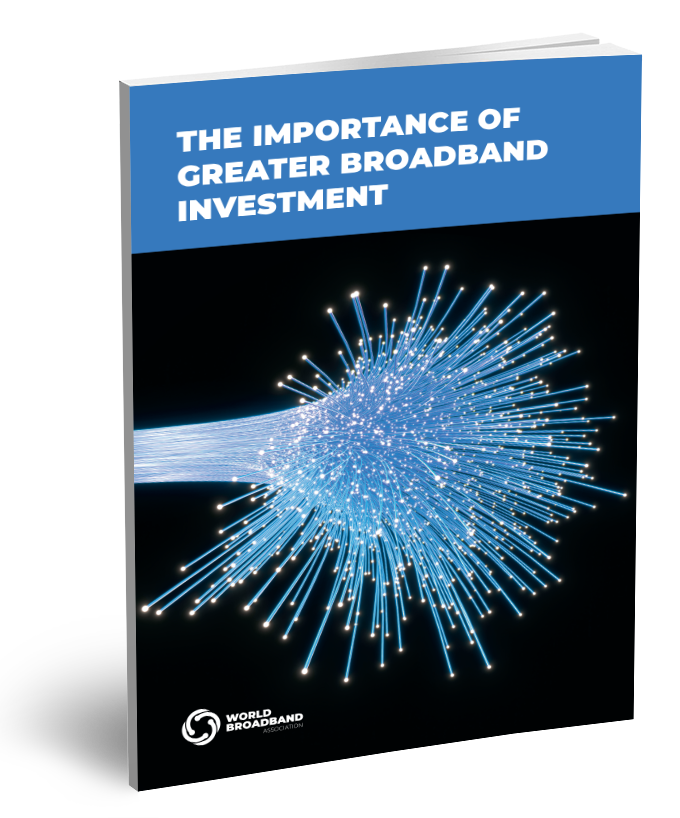Global Report
The Importance of Greater Broadband Investment
Michael Philpott
Research Director, Service Provider
– Consumer, Omdia
Hwee Xian Tan
Senior Analyst, Service Provider
– Enterprise, Omdia
Michael Philpott
Research Director, Service Provider
– Consumer, Omdia
Hwee Xian Tan
Senior Analyst, Service Provider
– Enterprise, Omdia
The Importance of Broadband to Socioeconomic Development
Figure 1: Broadband benefits in socioeconomic development are widespread
Source: World Broadband Association
Fixed Broadband Brings Maximum Economic Impact at Scale
Broadband technologies help grow national economies through both direct and adjacent monetization. Modelling carried out by the ITU for the report entitled, How broadband, digitization and ICT regulation impact the global economy (ITU, 2020), quantified this impact, showing that the level of benefit increased in line with broadband penetration and that the greater the broadband maturity of a country, the more capable it is of increasing product digitization and thus further driving its economic impact (see Figure 2). Interestingly, the ITU found that this is in direct contrast to the impact of mobile broadband, which tends to have a much bigger impact in emerging economies with lower penetration, with a lessening impact as penetration increases, largely due to diminishing returns.
The benefits of broadband, however, spread far beyond those that can be directly monetized. Broadband networks are now used to support a vast range of industries, from manufacturing to health institutions to educational facilities, as well as supporting more social aspects such as well-being and social equality (see Figure 1). The benefits that broadband brings in these areas are equally, if not more, important than those that can be directly monetizable.
Source: ITU
Broadband Quality is as Important as Basic Penetration
Source: Omdia
However, the above analysis is still fairly rudimentary and fails to show the more complex benefits advanced broadband networks can bring at a local level, nor any of the more hidden, non-monetizable benefits. By only viewing the top-level national economic benefits, governments may be in danger of making uninformed, incorrect policy decisions.
For example, analysis carried out by Briglauer and Gugler in the report, Go for Gigabit? First Evidence on Economic Benefits of (Ultra-)Fast Broadband Technologies in Europe (Briglauer and Gugler, April 2018), agrees that fiber-based ultra-fast broadband has a positive impact on GDP over and above the effects of basic broadband. But the paper also goes on to argue that, due to the increasingly high costs of rolling out fiber to more rural areas, after approximately 50% penetration, the costs of rolling out advanced fiber-based broadband networks start to outweigh the economic benefits. By only mainly considering the economic benefits of broadband measured through top-line GDP growth, the paper didn’t consider some of the more localized benefits, nor the more social benefits that broadband can also bring to areas of a country.
Indeed, in the report by Hasbi, Impact of Very High-Speed Broadband on Local Economic Growth: Empirical Evidence (2017), which is based on panel data covering more than 36,000 municipalities located in metropolitan France (excluding the three largest cities Paris, Lyon, and Marseille), from 2010 to 2015, it concluded that there is clear evidence that very high-speed broadband brings benefits for economic growth at a local level, including the creation of jobs, and an increase in entrepreneurship. This is on top of the social well-being benefits that very high-speed broadband also supports and is perhaps most needed in more rural areas.
Although the WBBA recognizes that all types of broadband technology have a role to play in the medium-term broadband evolution, it would caution only measuring the benefits of advanced fiber-based broadband networks by national economic metrics, and warns countries against creating potential multi-tiered digital societies based on segments of the population that have access to fiber-based ultra-high-speed broadband networks, and those that do not, especially in the longer term.
Fiber Networks Drive New Levels of Customer Experience
All the main types of broadband access technology (xDSL, cable modem, FWA, FTTP, and satellite) have advanced significantly over the years. However, fiber-based networks are still recognized as providing the most sustainable and future-proof communication networks of them all, with greater bandwidth, stability, reliability, and reduced latency.
Based on real network data from MedUX’s report, Residential fixed broadband in Europe (MedUX, 2019), Figure 4 illustrates how fiber outperforms other technologies in all areas. Such quality of service (QoS) KPIs have a significant impact on application quality of experience (QoE). Web browsing, video streaming, gaming, and cloud services experiences may all be heavily impacted depending on actual or average/median values but, most importantly, on the stability of those KPIs over time, especially during peak hours. As an all-fiber-based network not only outperforms other technologies on all QoS metrics but also has superior network consistency properties, it is proven to offer the customer the best service QoE.
This overall enhanced customer experience has provided fiber-to-the-home (FTTH) operators with a competitive advantage over other forms of broadband competitor in the form of superior net promoter scores (NPS) and reduced customer churn. For example, in 2019, the Spanish operator Masmovil topped the network quality rankings with its FTTP network, enabling it to boast an NPS ahead of its competitors at that time. A second example is Bell Canada, which has highlighted that its churn rates are lower when customers are on a full-fiber (FTTH) network. On average, the company found that churn rates for fiber access subscribers are 30–35 basis points lower than those on fiber-to-the-node (FTTN) or
digital subscriber line (DSL) networks.

xAs with consumer services, fiber to the business (FTTB) ensures enterprises with an optimal network performance have a more reliable, stable, and faster service, providing a future-proof network to maximize operational efficiencies, as long as it can be provided at the right cost.
Source: MedUX, Omdia
Future Applications Will Demand More
In 4Q21, the WBBA carried out a survey of 75 broadband service provider executives (Thought Leadership Service Provider Survey) and 75 enterprise executives from outside of the telecom industry (Thought Leadership Enterprise Survey). Based on results from respondents from the Thought Leadership Service Provider Survey, it is clear that broadband service providers expect that future consumer applications will continue to require greater download and upload speeds, as well as a higher level of service consistency (see Figure 5).
Figure 5: Service providers expect future applications will need greater speed and service consistency
Source: Thought Leadership Service Provider Survey, World Broadband Association
Interestingly, service providers are not expecting a requirement for even lower latency and jitter compared to existing applications, at least in the short term. However, in the medium-to-long term, as cloud applications become increasingly advanced and real time in nature, the requirement for ultra-low latency and jitter on top of ultra-high speeds is inevitable. The following sections explore just two examples of future applications that require advanced broadband networks.
One of the most exciting developments in both consumer and enterprise internet applications is the development of augmented (AR) and virtual reality (VR). It is currently most common to use AR and VR independently, with AR mainly being used (certainly in the consumer space) in mobile applications and VR via VR headsets for applications such as VR gaming. However, the blurring of the line between AR and VR is inevitable, and research by Omdia suggests that we will see more tangible examples of mixed reality (MR) emerging in 2022.
One of the most interesting aspects of MR development is the potential creation of the “metaverse” – a virtual world facilitated by the use of high-quality video, mixed with AR and VR. Although the term “metaverse” first originated in 1990s science fiction, the concept has gained traction in recent years with some seeing it as the future default way of interfacing with the internet.
AR glasses and MR headsets are currently almost entirely used for enterprise applications. VR headsets are more common in the consumer market, but are still relatively niche, with only 2.3% household penetration on a global basis based on Omdia’s research. However, VR is now taking steps toward becoming a mass-market proposition, largely driven by increased investment from Meta (Facebook), and AR glasses are expected to go mainstream from 2025 onwards.
The demands on the network from MR applications will be huge, with ultra-high-resolution VR applications requiring network speeds of at least 1Gbps and end-to-end latency of 8ms or less.
Digital gaming is one of the largest digital media industries in the world, worth approximately $200bn by 2025, according to Omdia. Cloud gaming still represents a small portion of that revenue but is the fastest growing gaming sector with an estimated CAGR of 5.3% by 2025, compared to mobile gaming’s CAGR of 3.0%.
The non-cloud game subscription model is already gathering pace, and this move to subscription models will form a natural step toward greater cloud gaming. Aside from Xbox’s big Game Pass push, major publishers such as EA and Ubisoft are embracing subscriptions. At the end of 2020, Fortnite was one of the latest titles to launch its own subscription – as did eight out of the top 15 highest-grossing mobile games in 2020.
The big advantage of cloud gaming is that with much of the intelligence pushed into the cloud, content can be accessed on virtually any connected device rather than more specialized, expensive devices – reducing barriers to entry in a similar way to the Netflix model in the online video space. This not only increases the potential subscription market but also the advertising one, and it is therefore no surprise that hyperscalers such as Google and Amazon, as well as other digital companies such as Netflix, are already actively investing in the cloud gaming space.
Cloud gaming, however, has different network requirements to cloud video, relying on an uninterrupted and consistent level of connectivity, with drops in latency having a great impact on the gaming experience. Speed remains important, with GeForce recommending at least 25Mbps for a 1080p at 60 frames-per-second (FPS) service, but with cloud gaming sessions lasting potentially hours at a time, low latency and high consistency are now essential to the gamer’s level of experience.
Edge Versus Fiber
Over the years, there has been a push for greater intelligence to be placed in the cloud. This has a number of advantages, from reducing CPE costs to being able to support advanced technologies such as big data analytics and new cloud services. However, as more applications start to rely on real-time communication, bandwidth, latency, and service consistency become an issue.
There has therefore been more of a recent trend around “network edge” – pushing the portions of an application that requires ultra-low latency as close to the customer as possible, while maintaining the overall advantages of the cloud. However, with the increasing rollout of all-optical fiber and 5G networks, much of the requirements for network edge start to fade.
That is not to say all intelligence can once more flow to the cloud. Placing more intelligence in the cloud increases cloud server costs where economies of scale can often be hard to achieve – which is a fundamental requirement of most broadband service business models, especially around IoT. There is an argument, therefore, to keep at least some of the intelligence in the local area network, which, as well as reducing service costs, keeps customer data securely located in their own network.
Enterprise Perceptions of the Criticality of Broadband for Industry/Business Growth
Continued enterprise growth and innovation are key to GDP success. Faced with the challenges of COVID-19, the demand for broadband connectivity and bandwidth within businesses has increased significantly and is expected to continue rising. Both enterprises and broader industry ecosystems are actively looking at broadband’s role in enabling digital transformation for enterprises and industry verticals to battle the tide of uncertainty at the moment.
WBBA’s 2021 Thought Leadership Enterprise Survey shows that 56% of business respondents said they need faster and more reliable internet to run their business applications. The ability to create meaningful customer experiences will hinge largely on connectivity, and 56% of surveyed respondents also indicated that they need faster and more reliable internet to meet their customer experiences and stay competitive (see Figure 6).
Figure 6: Enterprise’s access to current business broadband
Source: Thought Leadership Enterprise Survey, World Broadband Association
In developed countries at least, broadband providers are doing just fine in serving their business customers, but they do not inspire strong feelings, either positive or negative. However, technology support is lacking in most broadband providers, especially for many small businesses that lack fluent digital skills and are unprepared to deal with a pandemic of this scale. Omdia’s 2020/21 SoHo and SME Insights Survey has shown that small businesses expect service providers to help them navigate the pandemic and future challenges. Notably, different buyer personas agree that providing support is more important than a lower price (see Figure 7).
B2B customers: How CSPs can help in pandemic
Business owner/managing director
1. Better/higher-level support
2. Guidance and advice on solutions
3. Billing relief/reduce prices
IT/network manager
1. Better continuity
2. Better/higher-level support
3. Billing relief/reduce prices
Office/facilities Manager
1. Better/higher-level support
2. Faster deployment of new tech
3. Billing relief/reduce prices
IT/network manager
1. Guidance and advice on solution
2. Better/higher-level support
3. Billing relief/reduce prices
Source: Omdia’s SoHo and SME Insights Survey 2020/21
Enterprises’ Reliance on Broadband Providers has Grown
Broadband service provider websites have become a leading focus of engagement and guidance on digital issues for enterprises, second only to a general web search, according to Omdia’s 2021 B2B Customer Engagement Survey, which queried a cross-section of telco B2B customers. This is a major departure from past customer preferences, according to Omdia’s historical surveys (see Figure 8). Service provider websites must now stand up to higher expectations in both content and functionality as website traffic rises from more enquiring and needy visitors.
Broadband Access Revenue Climb
The importance of broadband is reflected in enterprises’ reported spending intentions. Omdia forecasts that fixed broadband will have the strongest revenue growth out of the five core network services (see Figure 9). The trend of SD-WAN and hybrid networking is making enterprises more accepting of broadband internet in their mix of access points. Besides, enterprises are increasingly using broadband as the primary form of connectivity for smaller branches, where network performance is less critical and outages have a limited impact on overall operations.
Figure 9: Core network services revenue, 2017‒25
Source: Omdia
Figure 10: How do you expect your organization’s expenditure on communications and digital services below to change this year, compared to last year?
Source: Thought Leadership Enterprise Survey, World Broadband Association
Vertical Industries Need Broadband for Industry Transformation
Under normal conditions, broadband connectivity usually translates into productivity improvements by facilitating the adoption of more efficient business processes (e.g., marketing, inventory optimization, and streamlining of supply chains); in accelerated innovation by introducing new business applications and services; and in more efficient functional deployment of enterprises by maximizing their reach to employees using videoconferencing and collaboration tools, access to raw materials, and to customers.
Looking further ahead, industries are moving toward more fundamental digital transformation provided by better connectivity.
Manufacturing and supply networks worldwide are undergoing digital transformation under the umbrella of Smart Manufacturing and Industry 4.0. The AI-enabled digital transformation provides an opportunity to address product lifecycle issues, including design, manufacturing, sustainability, and resilience. The adoption of AI-enabled technology results in increased connectivity, transparency, and visibility across digital supply networks.
The retail industry is undergoing a rapid and dynamic digital transformation process. This rapid growth of technologies such as AI, mobile technologies, AR, VR, and IoT is essentially changing the interplay between customers and retailers – therefore altering the retail landscape.
The broadband industry is in the lead to deliver the new immersive digital experience.
Health and social care organizations around the world are under pressure as populations age. E-health technology and services will provide a key role in providing future healthcare solutions.
Maximizing Socioeconomic Benefits
Closing the Digital Divide
As discussed earlier in this report, both mobile and fixed broadband penetration can help drive a country’s socioeconomic growth, with mobile broadband having the biggest impact in the early development of emerging broadband markets, then fixed broadband having a continued and longer-lasting impact as the markets mature. The report also outlines how more advanced broadband technologies are then required for continued and sustained growth. It is this continued investment that will enable more and more advanced applications and business innovation.
To enable all countries to maximize the potential of broadband, the digital divide discussion needs to move on from just focusing on basic connectivity penetration, toward a more involved and longer-term connectivity plan that can be split broadly into three phases (see Figure 11):
- Phase 1: Early, fast deployment of broadband services with a focus on mobile and other wireless technology to maximize basic internet coverage as quickly as possible.
- Phase 2: Increased focus on the rollout of fixed broadband access with a plan to get fixed broadband to 100% of all premises. This will ensure further socioeconomic development.
- Phase 3: A shift from driving broadband coverage to a continued long-term investment in advanced broadband technologies to move toward gigabit societies and beyond. It should be noted that phase 3 should overlap with phase 2 so that the latest broadband technologies are being deployed from day one, but it should also be recognized that the investment in broadband technologies will need to continue long after 100% coverage has been achieved.
Figure 11: Once the mass public is connected, focus must turn to advanced broadband rollout
Source: World Broadband Association
ETSI’s F5G Framework
The European Telecommunications Standards Agency (ETSI)’s Industry Specification Group (ISG) has created a framework for this continued broadband evolution, known as the “Fifth Generation Fixed Network,” abbreviated to F5G (see Figure 12). F5G aims to create the foundations for a structured approach to the evolution of the fixed network, establishing generational planning and promoting the expansion of a F5G network to as many sectors as possible. Although a significant aim of the ETSI ISG’s F5G is to facilitate the FTTE (“fiber to everything”) evolution to allow a complete end-to-end vision, it also considers other complementary last-mile technologies such as Wi-Fi 6/6E and 5G.
The characteristics of an F5G network can be characterized by ultra-high-bandwidth fixed broadband, full-fiber connection, and optimal service quality experience.
Figure 12: Features of F5G
Source: ETSI
Moving to More Advanced Broadband Networks Helps Drive the Green Agenda
The green agenda has become an important topic for national governments as well as private enterprises. Many broadband service providers have already adopted environmental elements to their list of corporate values. Moving to a 100% fiber optical network can help with such initiatives as fiber has several inherent properties that make it more environmentally friendly compared to copper-based networks.
Full-fiber networks require much less active equipment in the field to power them, significantly reducing energy consumption. An optical distribution network (ODN) literally requires zero electrical power. In addition, due to fiber’s significantly higher bandwidth capacity at a fraction of the size and weight of copper wiring, it requires significantly less power per bit. Typically, according to equipment vendor Huawei, for every 10,000 access connections that evolve from copper access to a FTTH gigabit passive optical network (GPON), the operator saves over 1,500kWh of power.
In 2019, Telefónica (Spain) stated that its FTTH network was 85% more energy efficient than its old copper infrastructure. Over three years, the operator said its FTTH initiative had saved 208GWh, representing a reduction of 56,500 tons in CO2 emissions. A study launched in 2017 by Europacable, a European organization representing wire and cable producers, also concluded that fiber is 64% more energy efficient than DOCSIS cable technology. It found that performing at 50Mbps, fiber networks consume 56kWh per capita per year compared to 88kWh for DOCSIS.
Due to its superior network qualities, the move to advanced fiber networks can also bring indirect environmental benefits by reducing commuting trips due to videoconferencing and more people working from home. Openreach in the UK, for example, estimated that by moving to a full-fiber network it would enable 230 million fewer commuting trips per year – equivalent to 700k tonnes of saved carbon.
Creating FTTP Business Models
According to the Thought Leadership Service Provider Survey (see Table 1), respondents stated that fiber to the home/business is the top investment priority to meet the needs of future consumer and enterprise applications. On the consumer side, this is closely followed by in-building fiber and then network virtualization. On the enterprise side, fiber to the building is closely followed by investments in network virtualization and IP technology.
Table 1: Where service providers will prioritize their investment to meet future customer needs
Investment priority | For consumer applications | For enterprise applications |
|---|---|---|
1 | FTTB/H | Fiber to the building |
2 | In-building fiber | Network virtualization |
3 | Network virtualization | IP technology |
4 | Fixed-wireless access | Enterprise CPE |
5 | Cloud network convergence | In-building fiber |
Source: Thought Leadership Service Provider Survey, World Broadband Association (n=75)
This result shows that the respondents understand that the power of broadband is maximized by investments in optimizing the end-to-end connection together with advanced cloud-based IT technology, with full-fiber network deployment being an essential element of this strategy for both consumer and enterprise markets.
However, moving to full-fiber networks has always been a challenge for operators, due mainly to the large expense involved in deploying fiber-optic cables to every premise in a country. This means that getting to 100% coverage will be difficult in most countries when based only on private investment. Based on responses from the Thought Leadership Service Provider Survey, respondents expected the fiber coverage to be able to increase to on average 70% of premises by 2030, but only 5% of respondents expected to be able to reach 100% coverage by that time, with 17% stating they still expected it to be only 50% or less.
The high cost of new infrastructure deployment can be easily offset if there is a clear return on that investment. In the past, however, network operators have often struggled to show a good enough return on investment, primarily because they focused heavily on revenue as a return – driven by higher-speed broadband services.
When one thinks of fiber one naturally thinks of high speed. Indeed, a key element of fiber’s claim of being “future-proof” is that its bandwidth capabilities are virtually unlimited. In the past, therefore, the business case for greater fiber rollout has largely focused on this higher speed and the search for “killer” applications that will justify speed upgrades by driving new revenue. Figure 12 shows that even in the Thought Leadership Service Provider Survey results, ultra-high speed, as well as the ability to deliver symmetrical speeds, was still seen as a key driver for the full-fiber business case.
However, concentrating only on the download speed benefits makes the business case for full-fiber rollout difficult to justify. Growing customer ARPU purely on higher speeds has historically proved difficult for service providers, and other service provider opportunities from future applications that could benefit from the rollout of fiber remain uncertain. On top of this, other copper-based broadband technologies such as advanced DSL or cable technology continue to improve, making it tempting from a business point of view to continue to sweat legacy copper infrastructure for longer, rather that make the jump to full fiber.
Source: Thought Leadership Service Provider Survey, World Broadband Association
Broadening the business model for full fiber away from just revenue and accepting other business benefits that full-fiber networks can bring is therefore vital if successful business models are to be created.
As well as delivering a superior QoS experience and helping to accelerate socioeconomic growth, full-fiber networks have several other network benefits. Compared to copper-based networks, full-fiber infrastructure is newer, made of highly resilient material, and is more passive. These features mean that full-fiber networks need far less maintenance, and as they don’t require as much active equipment in the field to power them, their energy consumption is lower, and there is less need for field maintenance.
In addition, as optical fiber cabling offers significantly higher bandwidth capacity at a fraction of the size and weight of copper wiring, it uses far less cabling and fewer racks and switches than copper-based networks – saving both physical space and money. Finally, the smaller size of the optical cables makes it possible to deploy using a technique known as “micro-trenching,” which is cheaper, quicker, and less environmentally destructive than traditional telecom network trenches.
The Current Network Status
Only a Handful of Countries Will Reach 100% Full Fiber in the Next Few Years
Based on Omdia’s Fiber Development Index: 2021, the FTTP coverage was 43% at the end of 2020. Only three countries, Qatar, Singapore, and South Korea, had reached 100% coverage by that date, although China, Japan, and the United Arab Emirates are all in the high nineties. However, of the 81 countries covered in the Fiber Development Index, 26 (33%) had FTTP coverage of less than 20%, including some highly developed broadband countries such as the UK, Germany, and Australia.
Source: Omdia’s Fiber Development Index: 2021
A number of countries have already put more ambitions FTTP plans in place. For example, In February 2020, the French government set out a plan that aims to achieve 100% fiber coverage by 2025. However, setting coverage targets is only part of the story. For these targets to be achieved, particularly in rural areas, it will be vital for governments and regulators to provide additional support.
Where Service Providers Need Most Help
The cost of deployment is an obvious barrier to greater fiber rollout and, as shown in Figure 15, is the number one perceived challenge stated by the respondents to the Thought Leadership Service Provider Survey. However, it is certainly not the only challenge that service providers face. As Figure 15 also shows, a lack of information over the location and availability of key infrastructure, as well as easy access to that infrastructure, are also listed as key issues.
Interestingly, a lack of understanding of the full benefits of a full-fiber network, both internally within the operators as well as with their customer base, is also ranked highly.
Source: Thought Leadership Service Provider Survey, World Broadband Association
A number of countries have already put more ambitions FTTP plans in place. For example, In February 2020, the French government set out a plan that aims to achieve 100% fiber coverage by 2025. However, setting coverage targets is only part of the story. For these targets to be achieved, particularly in rural areas, it will be vital for governments and regulators to provide additional support.
When it comes to where operators need most government/regulatory support, therefore, it is less about financial assistance (although that will be necessary in most countries to connect the really hard-to-reach customers) and more about providing greater flexibility and changing regulations, where possible, that would make fiber investment easier (see Figure 16). Legislation to make it easier to locate and gain access to key infrastructure such as ducts, poles, and other infrastructure would also help with new infrastructure deployment. Although more complex, legislation should be considered regarding non-telecom infrastructure, such as access to infrastructure deployed for other purposes, to gain maximum efficiencies.
Source: Thought Leadership Service Provider Survey, World Broadband Association
In-Building Networks Require Special Attention
The final few meters of a wired broadband network can often be the most complex part because more often than not it will cross privately owned land or be located in a type of building such as an apartment block (often referred to as a multi-dwelling unit or MDU). One of the advantages of wireless broadband technologies is that they can bypass this requirement and therefore greatly speed up installation.
For wired broadband operators, however, to gain access to the building or to cross private land they must have written agreement (known as a wayleave agreement) from the land or property owner, which, due to simple logistics, can cause a significant bottleneck to deployment. If not regulated properly, in-building access agreements in the case of large MDUs can also lead to a form of service monopoly where residents of that MDU can only access a certain service provider as only that service provider has access to the building.
To stimulate greater FTTH deployments, therefore, it is vital that national regulations are created that simplify the wayleave agreement process and wholesale agreements are put in place that provide fair access to all operators looking to access that building.
To accelerate future rollouts, property developers could help by pre-installing fiber infrastructure both in the buildings as well as the local area. Governments should explore schemes that guarantee such investment as part of the planning process.
IPv6 and IPv6 Enhanced in the Cloud, 5G and Fiber era
With the development of new technologies, such as cloud computing, big data, artificial intelligence, the Internet of Things, 5G, and Fiber accesses, human society is entering an era of intelligent connection of everything. The sudden pandemic has accelerated enterprises’ digital transformation for one to three years. Applications such as smart cities, online education, telemedicine and home office are constantly changing the life and work style of each person, every family and have profound impacts on enterprises’ operation and production modes.
With the number of connected objects and devices rapidly increasing, the last generation of IP protocol IPv4, which was developed over 40 years ago, is rapidly running out of available IP addresses.
IPv6 resolves this issue by moving from 32-bit address to 128 bit, effectively increasing the number of address by about 8 x 1028. This not only solves the problem of the number of network address resources, but also provides a foundation for the development of the Internet of Things. Additionally, IPv6 not only solves the problem of IPv4 address shortage, but by providing more objects connected to the Internet and protocol extensibility, IPv6 can further release the potential of Internet, bringing significant social and economic values, especially in technology innovations and network security.
Based on IPv6, IPv6 Enhanced improves IP network capabilities in six further aspects:
- Ultra-high bandwidth: continuously release ultra-high bandwidth to meet the challenges of future service uncertainty.
- Ubiquitous connectivity: provides flexible multi-service bearer and service-oriented network capabilities. Uses technologies such as SRv6 to implement end-to-end traffic scheduling, protocol simplification, network programmability, and user experience assurance, meeting multi-service convergent experience requirements.
- Security: IPv6 overcomes the defects of IPv4 and effectively defends against broadcast storms, fragment attacks, and scanning attacks. Each device can be assigned a globally unique IP address, implementing traceability of network attacks. In addition, IPv6 enhanced provides a new platform. New technologies, such as SRv6 and APN6, provide innovative means to solve network security problems.
- Automation: The automation capability enables automatic, self-healing, self-optimization, and autonomous driving networks. With key technologies such as artificial intelligence, on-demand detection, and knowledge graph, the fault recovery time is shortened from hours to minutes, and anomalies can be intelligently predicted.
- Deterministic quality: The deterministic quality creates a predictable deterministic experience for the IP network. The slicing technology is used to provide a secure, reliable, and predictable network environment and achieve jitter from ms to us/ns. The intelligent lossless network technology is used to achieve zero packet loss in the data center.
- Low latency: Low latency creates an immersive experience for real-time interaction between people and the virtual world. The end-to-end latency of the MAN reaches 10 ms. In a data center network, the static latency of device-network coordination is reduced from us to ns, and the single-hop dynamic latency is reduced from 10 to 100 us to 1 us, providing efficient data channels.
Best Practices for Government Support
The COVID-19 pandemic has amplified the need for fast, reliable, and low-latency connectivity, and policymakers must now recognize the need to evolve toward becoming gigabit societies. All the benefits of advanced broadband networks, both economic and social, direct and indirect, must be fully recognized so that its investment receives the required priority in policy planning.
In addition, strategies regarding the digital divide must shift from focusing only on getting the unconnected connected (i.e., only phase 1 below), and onto longer-term plans that evolve from basic connectivity to advanced broadband networks, and on toward gigabit societies.
This can be split roughly into three phases as discussed earlier in this report:
In order to seamlessly shift from one phase to the following, utilization of IPv6 is highly recommended. This will grant immediate adoption of IPv6 since the first phase in order to enable new services and future proof investment, avoiding future transition cost and investment in old technologies.
The public no longer needs to merely access basic internet browsing; instead, their broadband services must be capable of supporting a range of applications such as media streaming and video calling. Full-fiber (FTTH/B) networks are becoming the preferred solution for these purposes.
However, when looking to deploy fiber, operators face numerous challenges, prioritized in Figure 146ith the help of intervention from regulators and governments. Again, the ways governments can help are prioritized in Figure 16, and can be summarized as:
- Implementing regulatory flexibility including the removal of outdated or non-essential regulation
- Introducing flexibility in partnership arrangements, such as allowing agreements between players, co-financing, collaborative models, and public-private partnerships
- Facilitating deployment through municipality approvals, using existing resources (government buildings, streetlights, ducts, etc.), and sharing infrastructure/facilitiesntinued investment in advanced broadband technologies to move to gigabit societies and beyond.
- Providing financial assistance through investment support, incentives, and subsidies, e.g., universal service funds
- Improving access to telecom facilities and physical infrastructure; improving procedures for rights of way and accessing public infrastructure, as well as broadband mapping.
- Make IPv6 available to enable the rapid development of the Internet of Things.
The Role of the WBBA Can Provide Supporting Further Investment
The aim of the newly formed World Broadband Association (WBBA) is to help to bridge the digital divide, bringing together broadband industry stakeholders to maximize the social and economic benefits of equality of broadband as outlined in this report. The WBBA aims to bring influence through discussion, education, and promotion.
Given the priorities of service providers, as highlighted in the WBBA Thought Leadership Survey, areas where the WBBA will look to specifically support service providers and the wider broadband industry are as follows:
- Set out the importance of greater broadband investment, not just for the good of the service provider but for countries as a whole
- Promote regulatory, legislative, public relations agendas that help advance the interests of members through WBBA publications and live events, highlighting best-practice business models from around the world to remove any “lack of understanding at boardroom level”
- Through thought leadership, media activity, and live events, continue to make the case for what governments need to recognize and do to close the industry innovation, socioeconomic, and environmental benefits gaps through infrastructure investment
- Work with stakeholder partners to understand and promote the potential of future applications that will bring new benefits to broadband customers and the wider society
- Develop and highlight best-practice investment models that show the true return on investment of a full-fiber rollout to both private companies and government organizations
Champion the needs of its members to highlight barriers to future investment, creating a platform to enable open discussion between different types of stakeholder to encourage greater cooperation and new partnerships.
WHITEPAPER
The Importance of Greater Broadband Investment
This report analyzes the need for greater broadband investment to support continued socioeconomic growth, the barriers to that investment, and what governments and organizations such as the World Broadband Association (WBBA) can do to eliminate such barriers. It is available both online and as a downloadable PDF.










